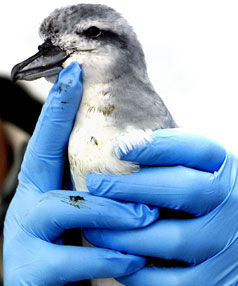
DOC is caring for more than a hundred weak and weary seabirds at its New Plymouth headquarters but thousands more were found washed up dead on Taranaki beaches.
Marine supervisor Bryan Williams said DOC was inundated with the disoriented and distressed birds, which are being kept in cardboard boxes, on Wednesday.
Mr Williams said DOC staff scoured beaches at low tide yesterday and found more than 3500 dead birds.
The majority of the birds are broad-billed prions with some Antarctic prions, thin-billed prions and the odd diving petrel.
"At this time of the year they come into the Tasman Sea to feed. It is unusual for people to see them because they are always well off-shore," Mr Williams said.
DOC staff and members of the public had been picking the birds up from right along the Taranaki coast.
"They had been rolling around in the surf and some of them had swallowed quite a bit of sand," he said.
The strong westerly winds were causing havoc for the birds.
"The birds start to get weak, so they just drift with the wind flow."
The birds were being cleaned and fed a mixture of sardines and water by DOC staff to help them recuperate before they will be released when the winds ease.
"We will continue to feed them until we can get the right conditions to take them back out to sea. Once they get out to sea they will be alright," Mr Williams said.
"They're mostly in good condition - until they were washed ashore they have been feeding quite well."
The situation was not unique to Taranaki - the Kapiti SPCA has had more than 500 birds dropped off to its shelter this week.
Ornithological Society New Plymouth member David Medway said the strong westerly winds had created the bird wreck which stretched the whole west coast of New Zealand.
"It's an unusual phenomena but it's a natural phenomena," Mr Medway said.
Seabird wrecks were unusual, especially on this scale, he said.
The last time a big one like this occurred was in 1974, he said.
Broad-billed prions, which nest mainly on the Chatham Islands, spend long periods of time at sea, he said.
"These birds are at sea a lot of the time and they have to battle those elements 24 hours a day."
And the ones that washed up on shore were only a small minority of the actual death count, he said. "For every one that gets wrecked on land, God knows how many get wrecked at sea."
They were an abundant species and such a sizeable wreck would not affect the species population too much, he said.
It was quite uncommon to see broad-billed prions on New Zealand shores which made them a special sight for ornithologists.
About Prions
A small seabird with the largest prion variety having a wingspan of up to 66cm and a body length of 30cm.
Social birds which nest in burrows.
They feed using a technique called hydroplaning, where the bird flies with its bill in the water and skims the surface.
Both parents incubate the egg for 50 days, and then spend another 50 days raising the chick.



Reader Comments
to our Newsletter